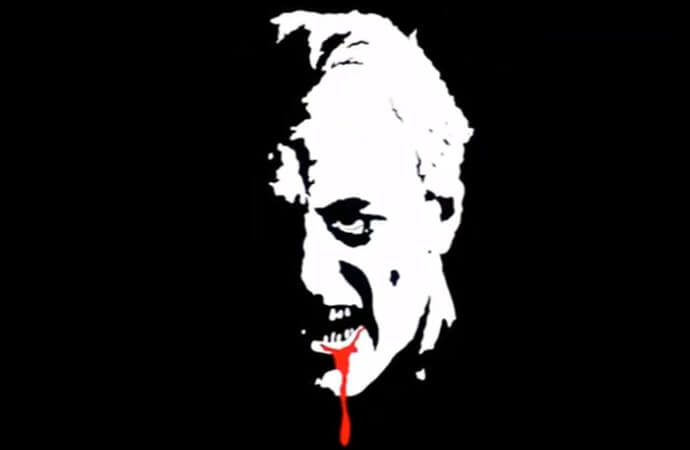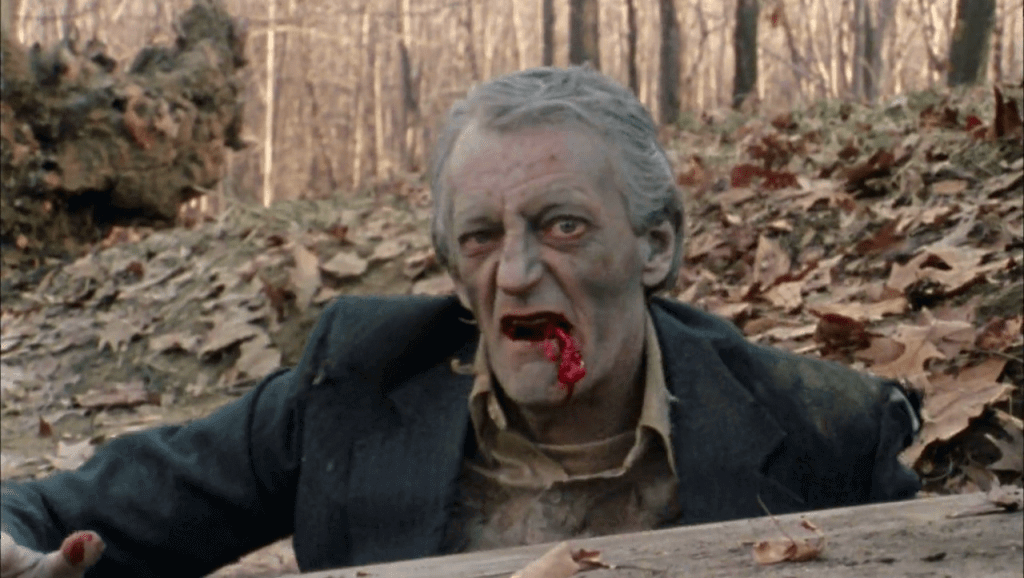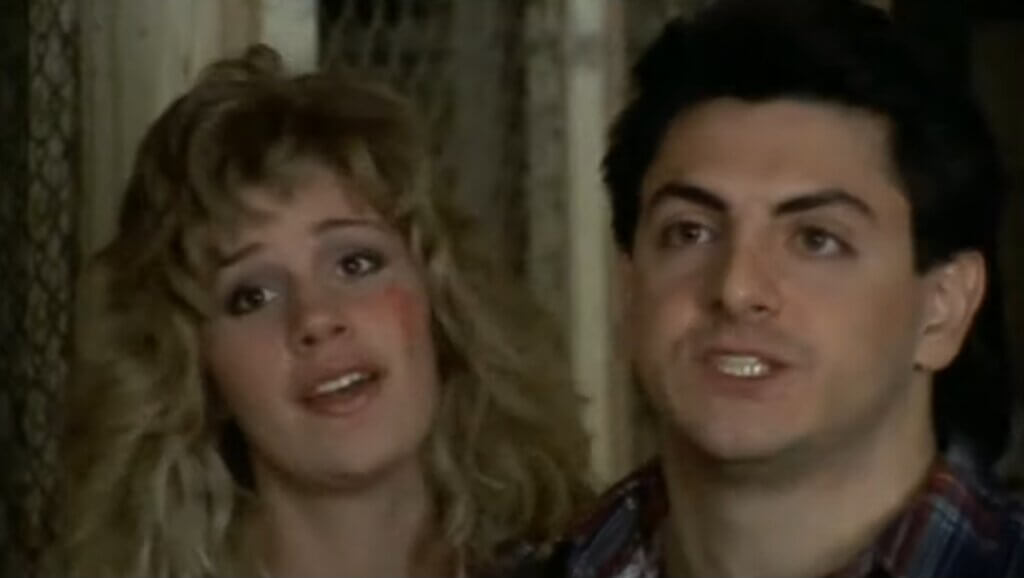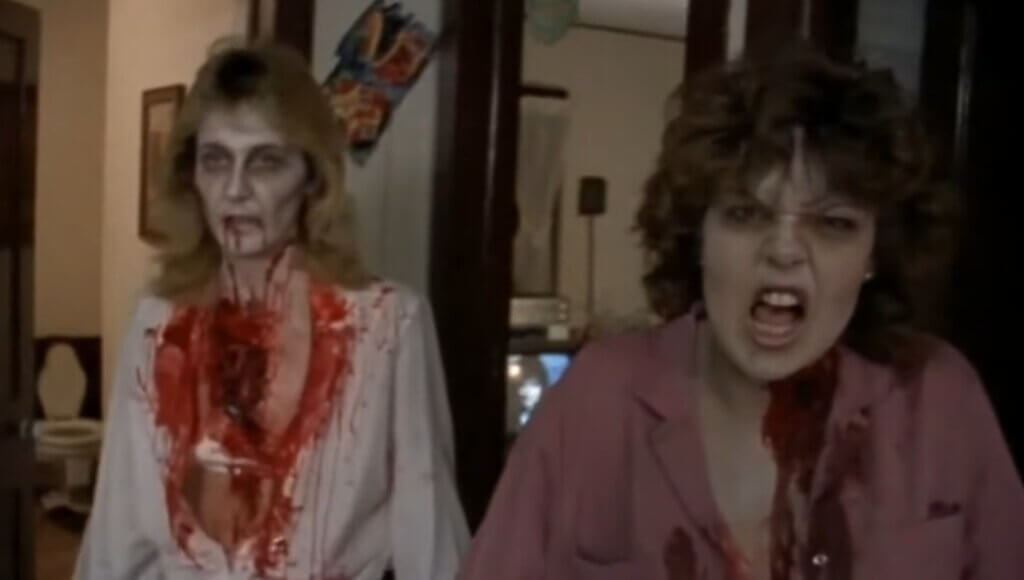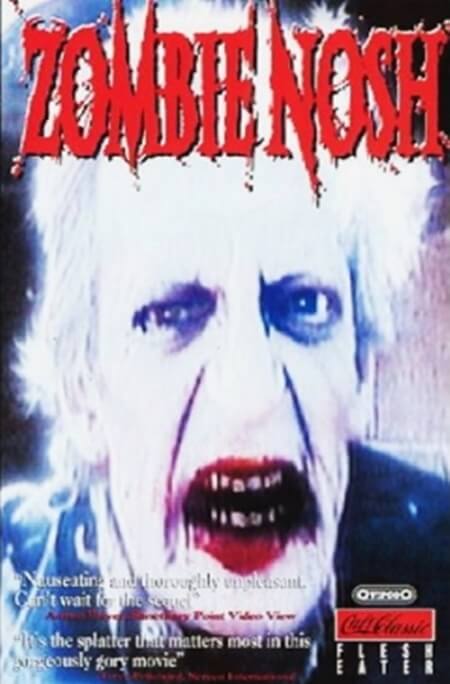Continuing a series that celebrates the fifty-fifth anniversary of Night of the Living Dead with a look at the classic zombie film and its many follow-ups.
While John Russo, Rudy Ricci and Russell Steiner wrote the script that eventually mutated into The Return of the Living Dead, they were not the only Night of the Living Dead personnel to embark on their own, Romero-free sequel.
Bill Hinzman contributed to Night as both a camera operator and actor: he played the “Graveyard Ghoul” who attacks Barbara and Johnny at the start of the film, lending him immortality as the very first zombie to appear in the Romero canon. After collaborating with Romero on some subsequent films, and directing a 1986 adaptation of John Russo’s novel The Majorettes, Hinzman took it upon himself to make his Graveyard Ghoul the star of a spin-off film.
Released in 1988, the movie is entitled Flesheater (or Flesh Eater, or FleshEater; online sources are undecided on this point) and was very much Hinzman’s baby. Not only did he star in it, he also wrote it, directed it, produced it, and chipped in with the editing. In the making-of documentary on Flesheater’s DVD release, he explained that the idea came to him after he visited a horror convention and was recognised for his role in Night of the Living Dead. Despite his personal connection to the original film, he still had to play things safe where copyright was concerned:
One of the funny things that happened was that I sent a letter with a photograph of me kneeling in front of a farmhouse with a girl in my arms to George Romero and to John Russo, and I promptly got two letters from attorneys back saying I couldn’t do that! And I promptly wrote back saying, “Why the hell can’t I?” And I did it anyway, so I think I changed the character enough.
The title card refers to the film as Flesheater: Revenge of the Living Dead, but the subtitle is absent from promotional material – it was, perhaps, a little too adjacent to Romero and Russo. The film itself makes no attempt to work Night of the Living Dead into its backstory, however, and instead comes up with a new origin for Hinzman’s Graveyard Ghoul.
Flesheater begins in a stretch of woodland that, we later learn, was once frequented by Satanists who performed acts of ritual human sacrifice. Here, a passing farmer stumbles across a stone with a pentagram carved onto it. Beneath this is another stone, this time bearing an ominous message: “This evil which will take flesh and blood from thee and turn all ye unto evil”
And beneath the second stone is the resting place of the Graveyard Ghoul, who wastes no time in converting the nosy farmer to the ranks of the living dead. Meanwhile, a gaggle of fun-loving college kids are hanging out in the same woodland, and it is only a matter of time before the zombie infection spreads through their number and contaminates the nearest neighbourhood.
With its emphasis on youth culture and setting of a small everyday community, Flesheater was possibly influenced by The Return of the Living Dead. If so, it does a remarkable job of failing to match that film on any level, let alone Night of the Living Dead. Return had its share of shortcomings, but Flesheater consists almost entirely of shortcomings.
The acting, dialogue and plotting are uniformly awful. The sound dubbing is also dubious: similar-sounding samples of guttural growls and moans are played over every scene with zombies, making the female ghouls sound oddly similar to their masculine counterparts. The budget clearly did not stretch to Return of the Living Dead‘s punk line-up and so the film’s songs were provided by HEDGG, a band that apparently specialised in sixties-style surfer rock, leaving the supposedly hip young MTV-era cast trapped in a weird cultural anachronism.
Listing the film’s flaws would take all day, while the positive points can be summed up in a paragraph. Flesheater has the occasionally half-successful dab of black humour, as when the Graveyard Ghoul turns up at a trick-or-treat house and feasts not on candy, but on a little girl. This is followed by a moment of (presumably) unintentional comedy courtesy of her father’s hilariously understated response: he surveys the carnage of his family with a thoughtful, hand-on-chin pose. The film also has some reasonably solid makeup and gore effects (courtesy of Jerry Gergely, who would later work on television’s Babylon 5); this last detail is hard to miss, given that each bloody prop is granted in a static close-up. With these few meagre glimmers covered, there is very little to write about Flesheater.
Perhaps the film shows a degree of novelty value in mixing the zombie genre with the slasher set-up of a lone killer stalking a band of victims, leading to the unusual concept of a slasher where the killer can multiply. But even this seems more like carelessness than innovation. After all, by 1988, the slasher and its bundle of cliches (including the “people who have sex get killed” chestnut, which is proudly displayed in Flesheater) had become practically synonymous with horror cinema and served as a default template. Plus, the whole selling point of Flesheater is the presence of Bill Hinzman’s Graveyard Ghoul, making it vitally important that his character is the one we see pawing topless girls: the slasher format simply gives him a better stage to do so than does the standard zombie template.
The only real defence that can be made of Flesheater is that the film was simply not meant to be good in the first place. Shoestring horror movies of this sort are not intended to be written about by cineasts; instead, they are designed solely to be jeered at by a gaggle of friends gathered around the VCR player with copious amounts of alcohol. Just as the same year’s Return of the Living Dead Part II is best approached as a horror film for children, Flesheater can be appreciated only as a horror film for drunk people. The alternate title of Zombie Nosh makes clear that the movie should not be taken seriously.
Yet even this tenuous plea fails to convince. The original Night of the Living Dead demonstrated that it was possible to make an entirely successful – indeed, groundbreaking – horror film with meagre resources. When Flesheater invites comparisons with its model, even making a botched effort to emulate the bleak conclusion to Night, the effect is merely sad. A sequel to Night of the Living Dead, even one as loosely connected as this one, should have been better.
Enter the splatterpunks…

